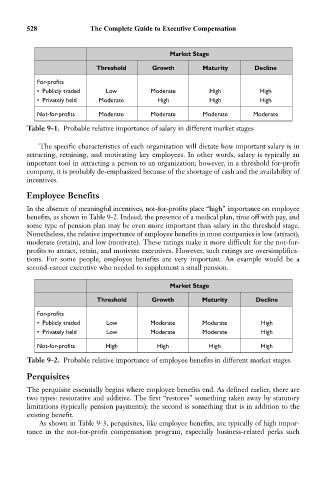Page 542 - Bruce Ellig - The Complete Guide to Executive Compensation (2007)
P. 542
528 The Complete Guide to Executive Compensation
Market Stage
Threshold Growth Maturity Decline
For-profits
• Publicly traded Low Moderate High High
• Privately held Moderate High High High
Not-for-profits Moderate Moderate Moderate Moderate
Table 9-1. Probable relative importance of salary in different market stages
The specific characteristics of each organization will dictate how important salary is in
attracting, retaining, and motivating key employees. In other words, salary is typically an
important tool in attracting a person to an organization; however, in a threshold for-profit
company, it is probably de-emphasized because of the shortage of cash and the availability of
incentives.
Employee Benefits
In the absence of meaningful incentives, not-for-profits place “high” importance on employee
benefits, as shown in Table 9-2. Indeed, the presence of a medical plan, time off with pay, and
some type of pension plan may be even more important than salary in the threshold stage.
Nonetheless, the relative importance of employee benefits in most companies is low (attract),
moderate (retain), and low (motivate). These ratings make it more difficult for the not-for-
profits to attract, retain, and motivate executives. However, such ratings are oversimplifica-
tions. For some people, employee benefits are very important. An example would be a
second-career executive who needed to supplement a small pension.
Market Stage
Threshold Growth Maturity Decline
For-profits
• Publicly traded Low Moderate Moderate High
• Privately held Low Moderate Moderate High
Not-for-profits High High High High
Table 9-2. Probable relative importance of employee benefits in different market stages
Perquisites
The perquisite essentially begins where employee benefits end. As defined earlier, there are
two types: restorative and additive. The first “restores” something taken away by statutory
limitations (typically pension payments); the second is something that is in addition to the
existing benefit.
As shown in Table 9-3, perquisites, like employee benefits, are typically of high impor-
tance in the not-for-profit compensation program, especially business-related perks such

